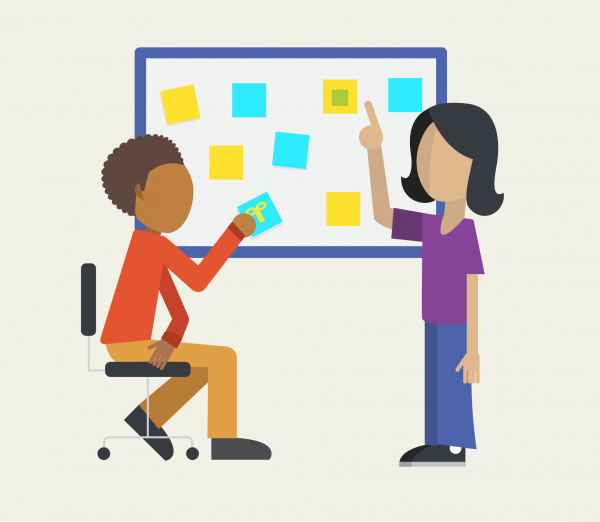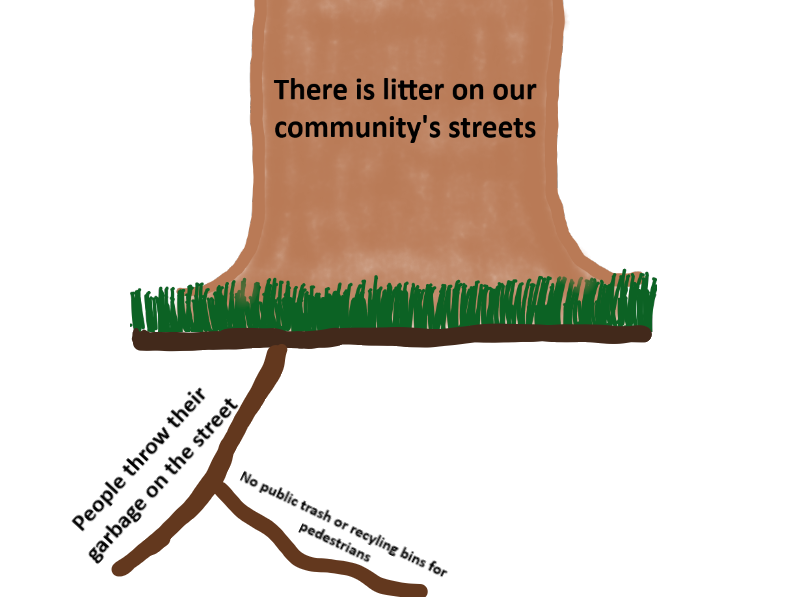
Students will examine the causes and effects of an everyday problem.
Tools/Materials Required: Poster board; markers; Sprout computer or laptops for a digital illustration (optional)
Depth of Knowledge: Skills and Concepts
Teacher’s notes are in purple. For the student’s version, see Problem Tree Student Guide.
This activity is based off the Problem Tree exercise, which is commonly used to better understand a problem by identifying its causes and effects.
In this activity you will illustrate a tree that represents three components of a problem:
By considering a problem’s many causes and effects, you should be able to better determine what could be a comprehensive solution to the problem.
Deconstruct
the parts of a tree and add it to your Museum of the Mundane. This activity gets students in the mindset to deconstruct complexity and also helps them build the visual for their problem tree. Take this to the next level by asking students to use the Parts, Purposes, Complexities thinking routine to deconstruct ‘A Problem’.
Practice the Five Whys technique to dig for root causes and underlying motivations.
Search for examples of completed Problem Trees on the internet. (The top half of this page is one example.) What are your thoughts on the example(s) you find? Do you think the causes and effects accurately relate to the problem(s) identified? On which parts of the tree would be best to take action?
Students can complete this activity in small groups or you can facilitate this activity as a class.
Step One: Identify the problem
With your peers, come to an agreement on a problem that you’d like to use for this exercise. Try to pick a problem that you and your peers either experience or observe in your daily life. For example: “There is litter on our community’s streets.”
Once you have come to an agreement, draw the trunk of your tree and write the problem inside of the tree trunk. Remember to leave ample space below and above the trunk for the roots and branches of your tree.

Step Two: Brainstorm the causes of the problem
Next, you will need to determine the causes of the problem. The causes of the problem will be represented by the roots of the tree. For each individual cause, you will draw a single root from the tree trunk.
One option is to have students spend a few minutes individually brainstorming as many causes as they can. When time is up, they can share their ideas with their group and decide the causes to place on their problem tree.
Brainstorm causes of the problem. Try to think of causes that you either experience or can observe. For example, in response to the problem “there is litter on our community’s streets,” you might write that “people throw their garbage on the street” or “trash gets left behind during garbage collection” as individual causes.

Step Three: Brainstorm underlying causes
Often, the cause of a problem has other underlying causes. For each cause you identified, ask “why?” to discover any underlying causes. For example, “why do people throw their garbage on the street?” or “why does trash get left behind during collection?” Try to focus on underlying causes that are experienced or observable such as, “there are no public trash or recycling bins for pedestrians” or “excess garbage falls out of the bin during collection.” If students do not have an answer for their question, they can write the question itself on the root. Write each underlying cause as an additional root that branches off the original root. The more you ask “why,” the deeper the roots of your tree will be.

Step Four: Brainstorm the effects of the problem
Next, you will determine the effects of the problem. The effects of the problem will be represented as the branches of the tree. For each individual effect, you will draw a single branch from the tree trunk.
Again, you could have students spend a few minutes individually brainstorming as many effects as they can. When time is up, they can share their ideas with their group and decide the effects to place on their problem tree.
Brainstorm effects of the problem. Try to think of effects that you either experience or can observe. For example, in response to the problem “there is litter on our community’s streets,” you might write “the garbage gets washed into the storm drains” as an individual effect.

Step Five: Brainstorm effects of the effects
The effects of a problem often have additional impacts. To find any additional impacts, ask “then what happens?” for each effect. For example: “The garbage gets washed into the storm drains. Then what happens? The garbage ends up in the local waterways.” If students do not have an answer for their question, they can write the question itself on the branch or leaf.
Write each additional effect as a branch or leaf off the main branch. The more you ask “then what happens?” the more branches and leaves your tree will have.

Step Six: Reflect
Once you have finished your tree, take a few moments to reflect:
Produced by Digital Promise Global, with thanks to the Open Educational Resources listed throughout this guide. Distributed to Learning Studios schools as part of HP, Inc. and Microsoft’s Reinvent the Classroom.
This work is licensed under a Creative Commons Attribution-ShareAlike 4.0 International License. You may share this project or modified versions of it under this same license.